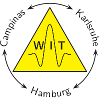Research Plan
Annex: Research topics (long term and short term)
This list contains research projects as well as long-term research goals and strategies. Please, note that a few topics may not be under current investigation due to the lack of people power. Since these topics are a vital part of the future research strategy they are listed here anyway. Some of the topics are considered by more than one team applying different approaches. The WIT research is divided into five subgroups.
Processing and Imaging
The Common Reflection Surface (CRS) concept plays a key role in the WIT research on
processing and imaging. The WIT hyperbolic CRS and non-hyperbolic i-CRS stacking
operators are based on this concept and represent the backbone of many research topics.
- global (ZO CRS) vs. local (CO CRS) approximations
- estimation of CO CRS attributes from ZO attributes
- 3-D i-CRS operator
- wavefield decomposition using stacking attributes (multiples, reflections, diffractions)
- utilizing super resolution
- pre-stack diffraction/reflection separation
- 5-D CRS and i-CRS interpolation and pre-stack data enhancement
- improved coherence measures (MUSIC, cross-correlation, analytical trace, etc.)
- optimization of multi-dimensional coherence analysis
- data driven isotropic and anisotropic time migration
- wavefield decomposition and filtering in the CSP domain
- inverse CSP mapping
- CRS and diffraction processing of 3-D hard rock data
- angle domain migration
- beam migration
- image wave re-migration
- migrated-domain CRS methods
Model building
Most of our model building approaches also exploit the CRS concept, which may be applied
in the data or time migrated domain.
- diffraction focusing velocity analysis
- passive seismic data velocity model update
- CRS based time to depth conversion•
- tomographic inversion of stacking attributes
Full Waveform Inversion
The FWI is moving toward applications to marine reflection seismic data, and near surface
seismic data (surface waves) and 3 component vibroseis data acquired in crystalline host
rocks.
- development of robust preprocessing of seismic data for FWI
- multi-parameter FWI
- source wavelet inversion accurate methods for geometrical spreading correction
- implementation of 3-D acoustic/elastic/viscoelastic FWI on HPC machines
- FWI in viscoelastic media
- optimization of Finite-Difference forward solvers used in FWI with respect to MPI communication, higher order time integration, variable spatial discretization and smooth free surface topography
- application of pseudo spectral methods in FWI
Modeling and RTM
In modeling and RTM we use FD, FE, and pseudo spectral approaches. Optimizations of the
computational effort is highest on the agenda.
- 2-D and 3-D RTM for VTI and TTI media (spectral methods)
- 2-D and 3-D acoustic and elastic RTM (FD methods)
- finite element elastic wavefield modeling
- computational optimizations of FD and spectral method approaches for acoustic,
- elastic, and anisotropic media, including benchmarking
- improved one-way wave equation
- reflection impedance description of reflection coefficients
- tuning effects in AVO and AVA
Passive Seismics
Passive seismic signals as a diffraction event provide the link to reflection seismics. Located
diffractions or micro-earthquakes provide natural Green's functions for reflection imaging.
- optimization of model-domain stacking and correlation based localization approaches
- high resolution full waveform relative event localization
- microtremor localization
- interferometric re-localization• development of fast time-domain localization technique
- localization uncertainties (apertures, velocities, bandwidth, acquisition footprint)
- real time processing methodology
